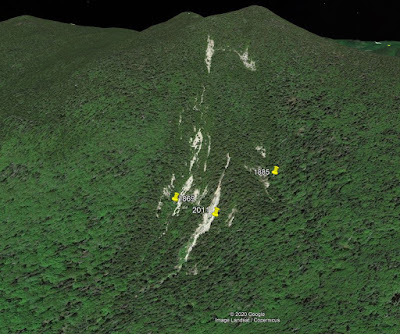After a morning jaunt to the base of the 1892 slide on East Osceola, above Upper Greeley Pond....
...and another morning trek on the ski slopes of Mt. Tecumseh, with a fine view of Mt. Tripyramid across the valley, it seemed fitting to do an all-day trek out to the South Slides, which regular readers of this blog know is a favorite destination of mine.
As I strolled up the familiar Livermore Trail, I kept an eye out for large or unusual trees, as Waterville Valley is working on a "Big Tree" program.
A mandatory stop at White Cascade on Slide Brook.
At 2.6 miles, I turned onto the Mount Tripyramid Trail, which makes a mellow 1.9 mile approach to the base of the South Slides. My plan was to visit all three of the South Slides: the 1869 slide, which the trail ascends; the smaller 2011 slide, just to the SE; and the two remaining open patches on the lower half of the 1885 slide.
I invariably take a break on a rock with a view of this small, mossy cascade on Slide Brook.
Trail scene on a grey November day.
A stout sugar maple.
Ascending towards South Tripyramid.
A yellow birch candidate.
The wonderful sugar maple stand at 2900 ft., just below the South Slides.
I bushwhacked over to the track below the 2011 slide, where this tree-creature is perched precariously at the edge of the gully.
Closer look.
Looking up the 2011 slide, which has an elevation difference of just 300 ft. from top to bottom.
Ledge slabs in the middle of the 2011 slide.
The ledges on the slide display a number of tan-colored aplite dikes - intrusions of fine-grained granite that cut across the monzonite bedrock.
Looking down the 2011 slide.
Nice view of Sandwich Dome and Jennings Peak.
Looking up the gouge of the slide.
Curving away below.
Mt. Tecumseh and its long south ridge extending out to Dickey and Welch.
Undercut.
Looking down from the upper part of the slide.
From there I bushwhacked across to one of two remaining open patches on the lower half of the 1885 slide, which came down during a downpour on August 13th of that year. (This was the same storm that triggered the huge North Slide on Tripyramid.) According to Alford A. Butler, who with several companions visited the scene two days later, on August 15, the second South Slide was even larger than the first (1869). Writing in the March 1886 Appalachia, he observed that together, the two slides had “made the fair mountainside a desert of rock. One is awe-struck and saddened at the extent of the havoc before him.”
The upper open patch of the 1885 South Slide is crossed by the Kate Sleeper Trail. The slide is revegetated between that patch (3750 ft.) and this patch (3300 ft.) and one just above. From here there is a wild and intimate view towards Sandwich Dome and Lost Pass.
Zoom on the remote, mystery-shrouded Lost Pass, the gap between North Flat Mountain and a spur of East Sleeper.
Mossy terrain on a wooded portion of the slide track.
The upper of the two 1885 slide patches that I visited.
Bushwhacking back across the slope, I got a look at the upper end of the 2011 slide.
Heading across to the 1869 slide, the route of the Mount Tripyramid Trail, I crossed another old slide patch.
Emerging on the 1869 slide and the trail. This one fell during an October 4 rainstorm and for many years was known as the "Great Slide."
Wide-open views at 3250 ft.
This small aspen is a survivor.

Gravelly descent.
A little birch glade just below the slide.
Long view through the high-elevation hardwoods.
Black Cascade on Slide Brook.
Sunset on Livermore Trail.
A nice treat at the end of a grey day.







































Beautiful. Is bushwhacking easier during stick season, Steve?
ReplyDelete